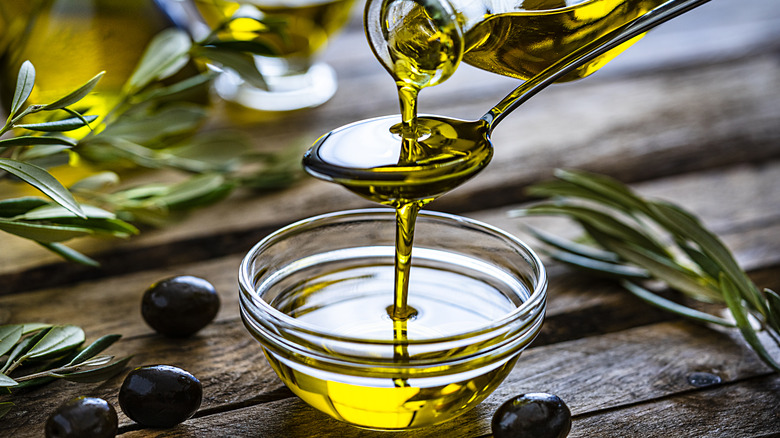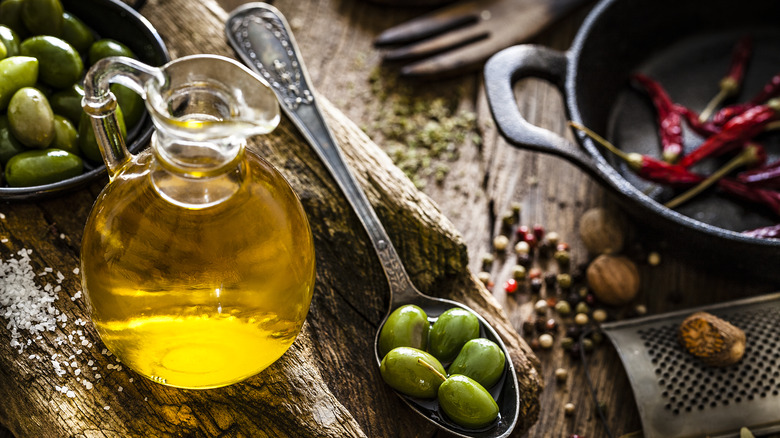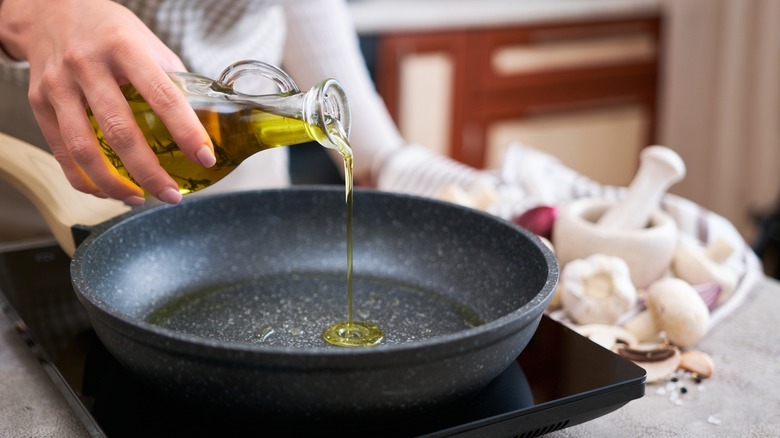The Difference Between Refined And Extra Virgin Olive Oil
Olive oil is subtle. It's not the main ingredient in your pasta or salad, but depending on the recipe, your dish isn't finished without it. And if you're just dipping bread into olive oil, then it is the main ingredient. When making dishes from certain cultures, it's a must: The country of Greece consumes the most olive oil worldwide, and it shows up in plenty of Greek dishes, although Spain produces the most olive oil.
You've probably seen the phrase "extra virgin olive oil" on bottles of the stuff in the supermarket. What makes it different from regular olive oil? In short, extra virgin is unrefined olive oil that hasn't been processed at all, and that purity makes it a favorite among chefs. On the other hand, what's sometimes called regular olive oil is usually a blend of virgin olive oil and refined olive oil, which has been heated and filtered to remove imperfections while also dulling its taste. In the United States, it's more common to find blends because 100% refined olive oil isn't sold in grocery stores.
How to spot unrefined olive oils
Before breaking down the numbers, it might help to quickly explain how olive oil is made. It's an old, very straightforward process: Harvest the olives, crush the olives, filter out the solids from the liquids, and then extract the vegetable water from the oil itself. The grade of the olive oil is determined through chemical testing. The best quality is labeled extra-virgin olive oil, the second best virgin.
To qualify as extra virgin-grade olive oil, according to the U.S. Department of Agriculture, the oil needs to contain a free acidity less than 0.8%. Free acidity, or free fatty acid content, refers to the amount of naturally occurring oleic acid in the oil. Extra virgin olive oil contains fewer free fatty acids than virgin oil, which can result in a different taste.
The result is a big difference in taste between refined and unrefined olive oil. Extra virgin oil retains more flavor from the harvested olives and is yellower (or even greener) in color, depending on the the olive variety and its growing conditions. Refined oil, on the other hand, is typically colorless with a milder flavor.
Why do you need refined olive oil?
It probably sounds like extra virgin is the easy choice when buying olive oil, and in many cases this is true. However, refined olive oil isn't sold for no reason. It has a much higher smoke point than extra virgin olive oil: The smoke point refers to the temperature at which the oil begins to smoke when heated. Refined olive oil begins to smoke at a range of 390-470 degrees Fahrenheit (199-243 degrees Celsius), while extra virgin smokes faster at 350-410 degrees Fahrenheit (177-210 degrees Celsius). This makes refined olive oil a better choice for cooking at higher heat.
Some folks say you should never cook with extra virgin at all, but this is an olive oil myth. Higher quality extra virgin has a higher smoke point, and even lower quality bottles can withstand cooking. That said, if you're frying a dish and the flavor's less important, then refined is usually cheaper. Extra virgin is the right choice if you're planning to serve it with bread, salad, pasta, or any dish where the flavor is important.


